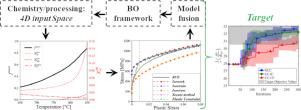Acta Materialia ( IF 8.3 ) Pub Date : 2021-01-08 , DOI: 10.1016/j.actamat.2020.116619 Danial Khatamsaz , Abhilash Molkeri , Richard Couperthwaite , Jaylen James , Raymundo Arróyave , Douglas Allaire , Ankit Srivastava

|
Materials design calls for the (inverse) exploitation of Process-Structure-Property (PSP) relationships to produce materials with targeted properties. Unfortunately, most materials design frameworks are not optimal, given resource constraints. Bayesian Optimization (BO)-based frameworks are increasingly used in materials design as they balance the exploration and exploitation of design spaces. Most BO-based frameworks assume that the design space can be queried by a single information source (e.g. experiment or simulation). Recently, we demonstrated microstructure-sensitive design of alloys with a BO framework capable of exploiting multiple information sources. While promising, the previous framework is limited as it assumes that the optimal microstructure is always feasible and considers microstructural features as the design space. Herein, we sidestep this unwarranted assumption and instead consider that chemistry and processing conditions constitute the design space amenable to optimization. We demonstrate the efficacy of our expanded framework by optimizing the mechanical performance of a ferritic/martensitic dual-phase material by adjusting composition/processing parameters. The framework uses thermodynamic results to predict microstructural attributes which are then used to predict the mechanical properties using a variety of micromechanical models and a microstructure-based finite element model. The final stage involves implementing model reification and information fusion, and a knowledge-gradient acquisition function to determine the next best design point and information sources to query. A detailed discussion of the various components and demonstration of how the framework can be implemented under three sets of cost-based constraints is presented.
中文翻译:

通过多信息源融合有效利用材料设计中的过程-结构-属性关系
材料设计要求(逆向)利用过程-结构-性能(PSP)关系来生产具有目标特性的材料。不幸的是,给定资源限制,大多数材料设计框架并不是最佳的。基于贝叶斯优化(BO)的框架越来越多地用于材料设计中,因为它们平衡了对设计空间的探索和开发。大多数基于BO的框架都假定可以通过单个信息源(例如实验或仿真)来查询设计空间。最近,我们展示了具有能够利用多种信息源的BO框架的合金的微结构敏感性设计。虽然有希望,但先前的框架是有限的,因为它假设最佳的微观结构始终可行,并将微观结构特征视为设计空间。在这里 我们回避了这种毫无根据的假设,而是认为化学和加工条件构成了适合优化的设计空间。我们通过调整成分/工艺参数优化铁素体/马氏体双相材料的机械性能,证明了扩展框架的功效。该框架使用热力学结果来预测微结构属性,然后使用各种微机械模型和基于微结构的有限元模型来预测机械性能。最后阶段涉及实现模型验证和信息融合,以及知识梯度获取功能,以确定下一个最佳设计点和要查询的信息源。











































 京公网安备 11010802027423号
京公网安备 11010802027423号